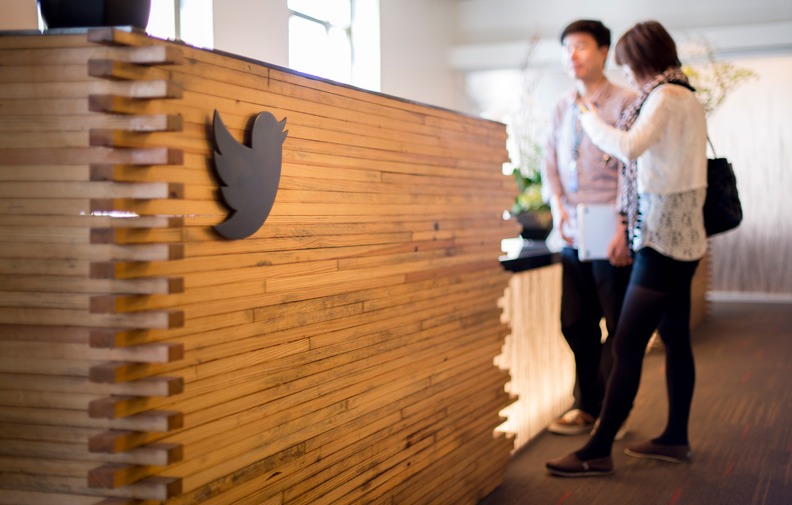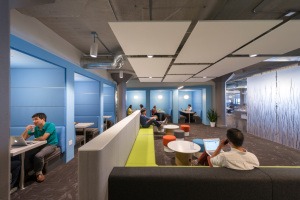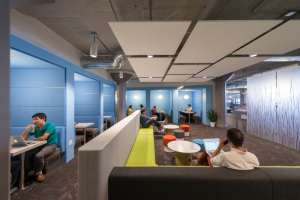By Benjamin Osgood, Contributing Columnist
As tenants transition from hard-lined telephones to VOIP, abandon private offices for open areas and clamor for “brick and timber” creative spaces versus “view space”, demand for less traditional office space is on the rise.

Twitter’s San Francisco HQ, designed by Interior Architects
Sure, it didn’t take a futurist to figure out that fax machines would soon be nothing more than an ancient office relic, but the cubicle? Along with the coffee maker and printing room, cubes are the last bastion of the traditional office, and according to workplace strategist Mary Lee Duff of Interior Architects, who recently completed the design of Twitter’s new San Francisco headquarters, demand for them is waning.
“The traditional concept of the high panel Dilbert cubicle has definitely been diminishing. The drive today is for workplace settings to be more open and collaborative with a strong emphasis on flexibility. For some clients that means going into benching systems, for others it is simply lowering the panel walls and being able to offer greater control over how to reconfigure one’s own space.”
Configurability of the office space is paramount to tenants’ desires; something cubicles do not intrinsically lend themselves to. Tenants are increasingly demanding fluidity and flexibility in almost a minimalist fashion. Big clunky cubes that cannot be reconfigured or moved without contracting a furniture installer are more frequently being replaced with workbenches (sometimes on wheels) and demountable partitions so as to encourage collaboration. Ms. Duff continues:
“With the rise of open collaborative planning there is a need to evaluate the right balance of both focused, contemplative spaces alongside the energetic buzz of open teaming areas. This is one of many challenges faced by design firms today in planning appropriate space that aligns workspace with the business, culture, and aspirations of each client.”
But foregoing cubicles for more flexible furniture options do not come without their challenges. Furniture on wheels can easily accommodate a quick reconfiguration due to a change in headcount or department consolidation, but where is the power and data going to come from? Interior Architects overcame this hurdle during a recent assignment by utilizing a raised floor that could accommodate multiple power and data plan configurations in a myriad of locations.

Twitter Headquarters, San Francisco
External influences to workplace design such as globalization, increased demand for sustainability and a changing demographic are also altering the face of the modern office. With employees regularly engaging customers and colleagues around the globe in different timezones, video conferencing and work/life slicing is gaining popularity.
Age, gender and ethnic diversity is also affecting the way offices are being built out and configured. I know of at least one tenant that has a prayer room for their muslim employees, and a “wellness” or “mothers’ room” for new mothers is fast becoming the norm in newly-built offices.
Several other trends that appear to have sticking power are the “work anywhere” mentality, increased importance of having face-to-face meeting areas, highly configurable or “hackable” walls and partitions, small and agile workgroups, and increased transparency whereby an employee can do a 360° spin in their chair and literally see the entire office.
Benjamin Osgood, LEED AP is Vice President, Tenant Representation Services at Dunhill Partners West, San Francisco, CA. Phone: (415) 684-1650 – www.dunhillpartnerswest.com
Discover more from Helping NYC & Long Island Commercial Tenants, Owners, and Developers
Subscribe to get the latest posts sent to your email.






One of the challenges in promoting an open environment are the “exceptions” such as HR and Legal. By providing these groups with private, lockable space, you venture down a slippery slope with other groups who are lobbying for the same with some very compelling justifications! One way of tackling this problem is grouping teams like HR and Legal together on a single floor or section of the office and creating security restrictions. You are still able to provide an open work environment, but there’s a social contract in place similar to the Las Vegas vacation rule: what happens here, stays here.
As a long-time facilities practitioner, I have witnessed a lot of hype, fads, trends, and real change. As mentioned in the article, there needs to be balance. True ‘work anywhere’ concepts work well in certain businesses, but it is not a ‘one size fits all solution’. Issues like voice privacy, social interactions, and – most importantly – ergonomics and employee health and safety need to be addressed. It is not just about collaborative work and space efficiency. It also needs to be about providing ergonomic solutions and proper training for how to use these workspaces safely. Working from benches, project bars, booths, soft seating, and small workstations is a recipe for ergonomic problems that can affect people’s health and cost companies money. Users AND managers need specific training for working safely in these environments.
Terrific summary of the impact of open plan, globalization, diversity and “work anywhare” trends!
Very Good Article! I am in the used office furniture industry and I have seen some of my clients make these changes and reconfigure for a more open look. They to have had the same concerns about power and date connections if they wanted a more versatile office environment using, modular or furniture on wheels. Before cubicles all offices were open and the reason for the cubicles was the noise. If you have 30 people in one room all talking and working at the same time it can become unbearable which is why cubicles will never go away. I am sure the new tech companies or companies who can get by with less employees and a more quiet environment will go forward with the open plan. Other companies like start ups and call centers will almost always buy cubicles. Especially the used and refurbished like I sell day in and day out. They are very high quality and can be configured and customized to the clients liking. Call center especially. 30-100+ people all in one room talking on the phone at the same time. I’ve worked for a call center. Between the phones ringing and the people reading their pitches or having their conversation cubicles are a must. Now, I know that even when the client buys the cubicles for privacy and noise reduction they still want the office to look good and have as much of an open feeling as possible. This is why some of the manufacturers use glass in some of their panels. We also carry a glass panel line which provides privacy but allows light to flow through the room normally and allows all the employees and managers to see one another while not being disturbed by each others work. Although I recognize the move towards the open office plan I do not think the cubicle will be dieing out anytime soon.
Louis, we too are seeing lower cube walls and use of glass partitions. I visited a facility in Stamford, CT recently at the invitation of a Steelcase dealer. Their client recently went through a renovation using the open office concept – 100k sq ft floor plates. To mitigate the noise issue, they complemented the design with sound masking devices throughout. I’ve always been dubious on its effectiveness but the place was amazingly quiet.
After successfully completing several new build-outs to an open plan system, some of the greatest challenges I have experienced are how to handle the objections and how to manage the cultural change many staff experience when now being forced to sit out in the open with less privacy than they previously may have had.
Proper change management before, during, and after the project, is a big part of keeping everyone happy. When moving people into an open area from what was a more private place; an office or semi-private workstation, there needs to be extra thought to accommodating needs for additional break out areas, and places for people to make private calls or hold meetings.
Richard, thanks for your feedback. This article was posted in a bunch of LinkedIn groups blogs and many comments/concerns seems to be employee acceptance and change management. I wrote an article in this blog on that particular issue: http://box5556.temp.domains/~ownersre/2012/07/10/being-pushed-into-open-office-concept/
No mention of coworking…?
http://www.youtube.com/watch?v=le0dfcG_jVw
Hi David, I wrote this article with a focus on spaces that are occupied by only one, single user, however am working on another about co-working where many companies occupy one space.
Space planners and facilities departments for corporate America should take this article to heart. Changes in the technologies we use (like VoIP, soft phones) combined with the continued increase in virtual workplaces is doing more than just changing how our cubicles are “wired” or how many cubicles we need. An effective work space must support how we work today – collaboratively, collectively. We are no longer just a work force of individuals, but actual cohesive teams driving for business results.
Very well said, Theresa!
I find this trend of “collaborative” is just the wheel turning but a new hip term for it. Watch any movie from the 1950s that has a workplace scene or two (The Apartment might one) and you’ll see this giant rooms filled with people crunching away on adding machines and typewriters. There were good reasons to abandon that then, they haven’t changed and, quite frankly, I have a sense that this “collaborative” idea is “kumbaya” in the office.
Thanks for reposting, Richard. I posted up a few photos from my tour of Twitter’s HQ here if you’d like to check them out: https://www.icloud.com/photostream/#A1532ODWg6r4t
IFMA is on the move and following a similar strategy. More info here: http://www.ifma.org/about/about-ifma/ifma-headquarters